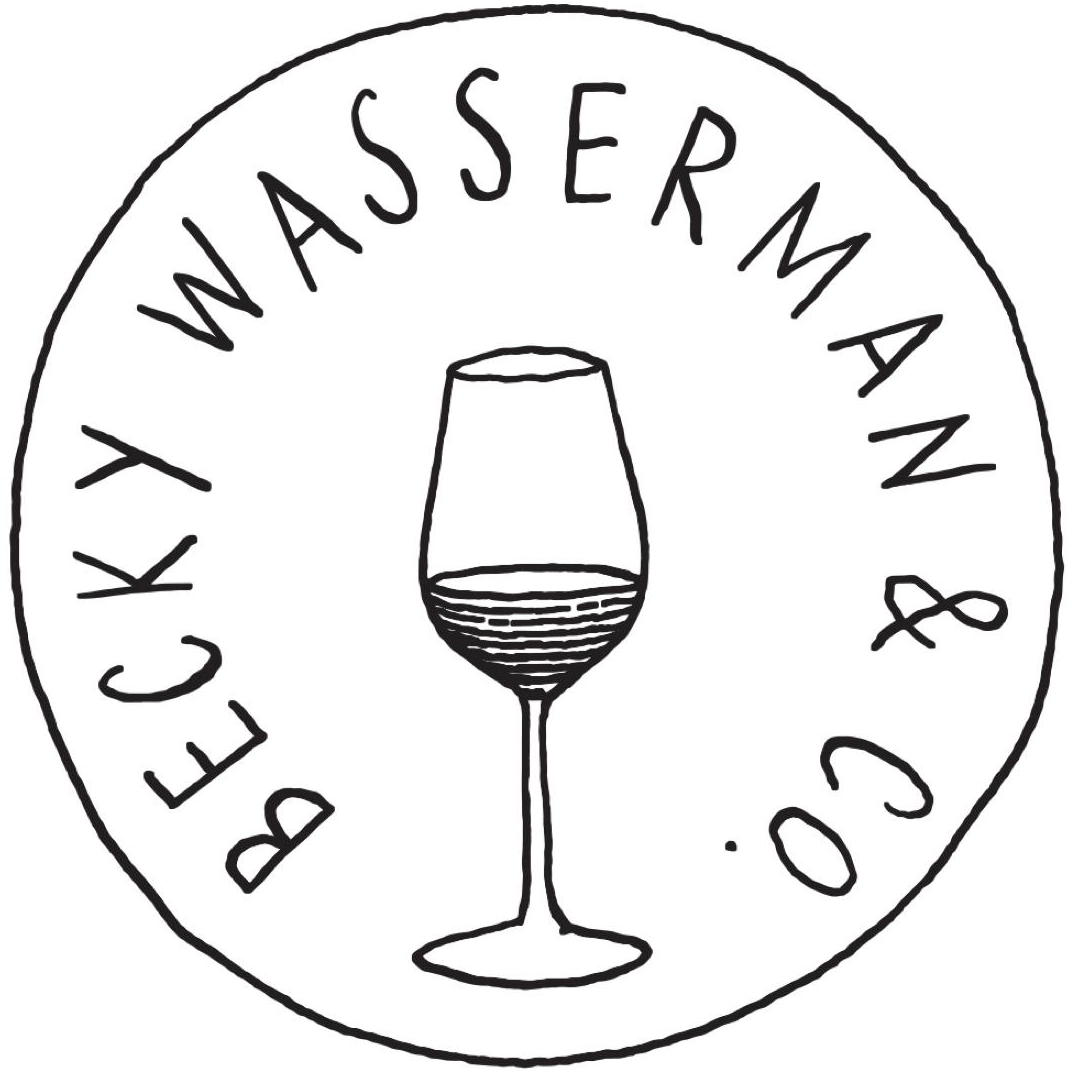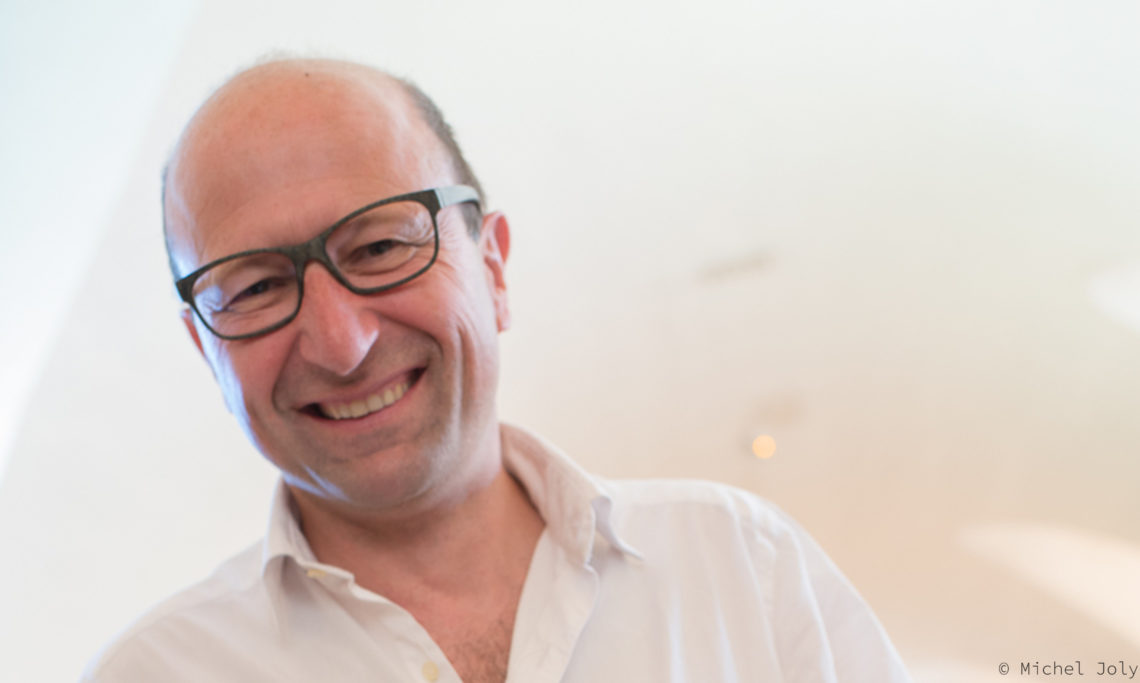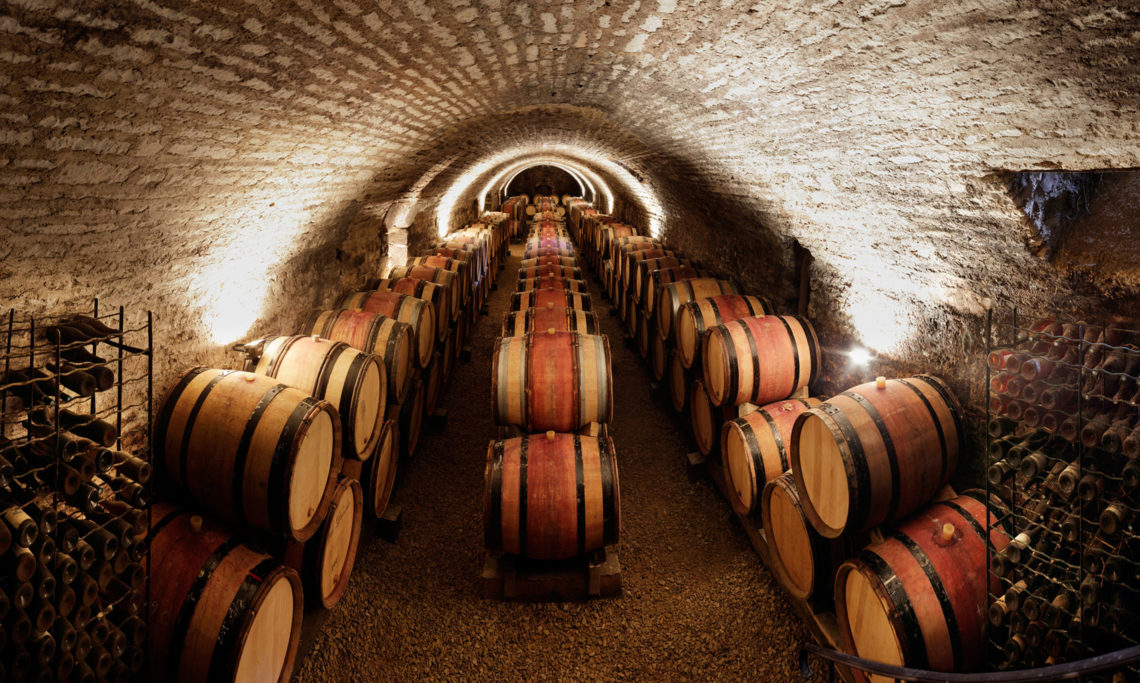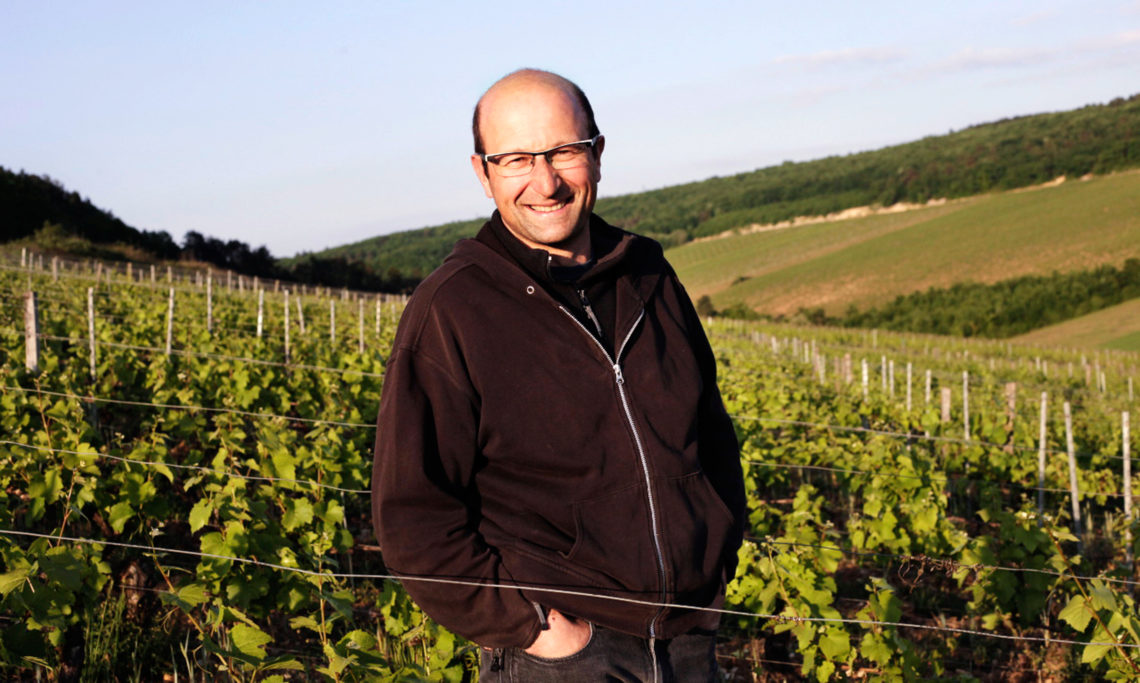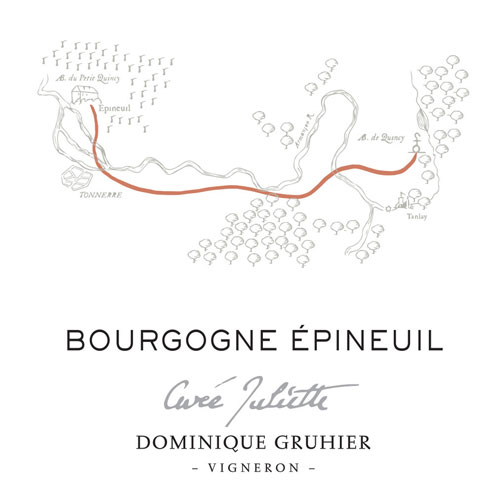Domaine Profile
- Location: Epineuil, Burgundy
- Size: 25 ha (61.78 ac)
- Varieties: Pinot Noir, Chardonnay, Pinot Gris
- Viticulture: Organic (Ecocert- USA and Europe, 2014)
- Vinification (whites): Ambient yeast fermentation, aged for 10-11 months in stainless steel tanks and used barrels (228 and/or 400 L), SO2 added in small doses throughout vinification and aging, approx. 35-45 ppm total at bottling.
- Vinification (reds): Up to 100% whole cluster (depending on vintage and cuvée), ambient yeast fermentation, aged for 10-12 months in 228 and/or 400 L barrels (0-30% new), SO2 added once a few months before bottling, approx. 25-30 ppm total at bottling.
In Brief
Dominique Gruhier has had a rough ride. Yet he is one of the warmest, most charming, welcoming, well-mannered, and smiling men we know. As his domaine and his (currently) obscure appellation attract customers, he has been able to make the investments and changes that were necessary to let his talent shine. What beautiful wines have emerged! Fine, sexy, juicy, vivacious, saline and chalky. They are some of the greatest values in our entire portfolio for Pinot Noir, but not just any Pinot Noir: Chablisien Pinot Noir.
Backstory
Dominique grew up in Tonnerre, only a mile away from the winery he now owns in Epineuil. Though his maternal grandfather was a négociant in the Côte d’Or, his parents didn’t have vineyards and weren’t in the wine trade. After high school, Dominique went to Dijon to study mechanical engineering, but soon discovered that engineering was not what he wanted to do.
At the same time he was in Dijon, Laurent Delaunay, a cousin of Dominique’s who would go on to create Les Jamelles, was studying at the lycée viticole in Beaune. Laurent would frequently invite Dominique to wine tastings. Dominique caught the wine bug, quit his engineering studies and enrolled at the Lycée Viticole; he planned to find a position in the wine trade. His studies completed, he enlisted in the army for his then-compulsory one-year military service. There he met a winemaker from Orange, in the southern Rhône, but whose father had planted for him 4.5 hectares of vines in Epineuil. “The son lived in Orange but would come up when there was work in the vineyards. In Epineuil he lived in a trailer above the vineyards,” says Dominique. “He had a girlfriend who would work in the vineyards without a bra. She was the village’s main attraction.”
It was much colder in Epineuil than in Orange, too cold for the son. He stopped making the trek, neglected the vineyards, and eventually put them up for sale. Dominique bought them in 1990. Six months later, a winemaker from Champagne put his vineyards in Epineuil on the market. Dominique’s father decided to buy those, as well as an old monastic grange, and to hire his son to take care of them and make the wine.
It was a great set-up and it should have been the start of a successful domaine. Unfortunately, what followed was a stroke of Chaplinesque poor luck that would set the domaine back for a decade.
A Series of Unfortunate Events
In 1990, the grapes from Dominique’s vineyards were contractually pledged to the local cooperative for three years. But when Dominique went to fill out paperwork, the co-op put in front of him a twenty-five year contract: if he didn’t sign, they wouldn’t purchase the upcoming vintage. Harvest was around the corner and Dominique had no winery and no equipment, but he refused to sign. Thankfully—he thought—he was loaned an old winery in Molosmes, a village ten minutes away. As it turned out, the winery’s old cement tanks were full of brettanomyces. Dominique’s first vintage, all of it, was undrinkable.
Then, in 1991, the vineyards froze, producing no crop to speak of, and Dominique’s father’s newly purchased winery was burned down by an arsonist. In 1992, his father rebuilt the winery, but a backhoe driver’s mistake made the cellar collapse. The same year, Dominique took on a series of clients who sent him grapes to vinify. He rehabilitated the Molosmes winery, paying for the old tanks to be treated with a special coating. It was never applied. All the wines he made in 1992 smelled like plastic trashcans. Eight years of lawsuits followed.
With all these setbacks, his father put the domaine on the market, where it remained for seven long years. Finally, reluctant to pour more money into the domaine, he decided to dump it at a loss. Dominique sold some of his vineyards to come up with a down payment and became the proprietor of the business, with a long-term lease from his father on the vineyards and the winery.
“It had been like the snake biting its own tail,” says Dominique. “Without money, you couldn’t make the necessary investments to produce better wine. And so you never made money.” But, as his own boss, Dominique made the necessary changes.
Viticulture
Starting in 2003, Dominique began to organically farm all of his Côte de Grisey. The rest of the domaine was farmed with only minor synthetic treatments around flowering time. In 2010, he began the organic certification process for the entire domaine. In 2012, overrun by the appalling vintage conditions, Dominique made one synthetic treatment, and even that not on all of his vines. “It was useless anyway because I sprayed too late,” he says. He had expected Ecocert, the certifying agency, to dock him for a single year, but it ordered him to start the three-year process over from square one. Organic certification for the entire domaine is expected in 2016.
In 2011, Dominique planted a conservatory to preserve the genetic diversity of his vineyards through massales selections. For example, there is a particularly good selection of Pinot in the Dannots, originally from the Aube, only a half-hour drive from Epineuil. It produces very long bunches that are loose and aerated, with a morphological resistance to rot.
Vinification
On the winemaking front, it has taken Dominique practice to learn how to best work with the assertiveness of his terroir.
“When I began [pre-global warming] there were years when the wines only reached 10 or 10.5 degrees alcohol. They were undrinkable,” he says. “It took time to comprehend the terroirs, time to get over the desire to produce monster wines. There is already an intense fresh minerality, but stone is not butter. If you add unripe tannins to the minerality, you get wines that taste triangular. It’s not Chambolle here. I’m getting better. But when I was young, I made conneries de jeunesse, stupid youthful mistakes.”
In 1999, encouraged by Francois Ecot from Jenny and Francois, and with help from Philippe Pacalet, Dominique began making natural wine. He did so until 2006, when his cuvée Juliette was so full of brettanomyces that he couldn’t drink it, and he was forced to sell it all to négociants. Since then he has pulled back: there are moderate amounts of sulfur on most of his wines; Juliette and Dannots are vinified and aged without sulfur until bottling. These two cuvées are also made primarily with whole clusters, up to 100% when the vintage allows.
But What the Hell is Epineuil, Anyway?
The village of Epineuil is located just 10 minutes northeast of Chablis. As in neighboring Chablis, the geology is Kimmeridgian.
Bourgogne Epineuil is the regional AOC for the reds and rosés produced in the village of Epineuil. The AOC was created in 1993. The reds are produced from Pinot Noir, whereas the rosés can be produced from Pinot Noir and Pinot Gris. There are 65 hectares under plantation (source: Inside Burgundy, Jasper Morris.)
Bourgogne Tonnerre is the regional AOC for whites, for an area that includes six villages: Epineuil, Dannemoine, Junay, Molosmes, Tonnerre and Vézinnes. The AOC was created in 2006, prior to that the whites were also part of the Bourgogne Epineuil AOC. Whites are produced from Chardonnay. There are only 38 hectares under plantation (source: Inside Burgundy, Jasper Morris.)
Crémants produced in Epineuil fall under the Crémant de Bourgogne appellation.
“I stood behind my Epineuil sign at trade shows and wine fairs” says Dominique, “and no one wanted to taste. I’ve done three-day trade shows where only one person tasted.”
But even though it is little known, what we have in Epineuil—particularly on the Côte de Grisey, with its near non-existent topsoil and up to a 45% grade—is Pinot planted on one of the great historical terroirs for Kimmeridgian whites. Planted to Pinot Noir like it is today, it produces reds that are stunningly distinct and assertive. Their mid-palate is intensely mineral, and their finishes long and chalky. The fruit is so vibrant and acidulated in red fruit vintages that it feels bioluminescent, and even black fruit vintages in Epineuil have the energy of red fruit. Dominique’s whole-cluster, light extraction, low sulfur winemaking is fruit-driven and transparent. Rare are the pinots in Burgundy that combine such vivacity, chalkiness and sexiness.
Smart people will get past the regional classification and think of these not as Bourgogne but as Epineuil, which nineteenth century authors thought was superior to Irancy. Not only are Dominique’s wines some of the greatest values for Pinot Noir in our portfolio, they have a magnificent identity.
Of the Rise and Fall of the Wines of the Tonnerrois
Shortly after its foundation in 1098, the Abbaye de Citeaux founded a number of “daughter” abbeys. The second of these daughters is the Abbaye de Pontigny, founded in 1114, 20 kilometers north of Chablis. It is credited with having developed several vineyards in the area, including those of Chablis and the Tonnerrois.
In turn, Pontigny founded its own daughters, including the Abbaye de Quincy, established in 1133 ten kilometers east of Epineuil. In 1212, Quincy built a monastic grange in Epineuil, which the monks used for the production of wine and as a summer residence. It would later be known as Le Petit Quincy, and is now Domaine Dominique Gruhier. It is a sizeable grange, and attests to the importance of wine production in Epineuil.
During the High Middle Ages (12th and 13th centuries) it was not the wines of the Côte d’Or but those of the Auxerrois and the Tonnerrois that made the reputation of Burgundy in Paris and beyond. They were easier to transport to Paris because the Yonne river was navigable from Auxerre, whereas the wines of the Côte d’Or first had to be carted to the Yonne, at Cravant. In fact, it wasn’t until a royal ordinance of 1416 that the wines produced in the pais de Beaunois (the region of Beaune) were included in the Burgundy appellation. Prior to that, only the wines produced in the pais de l’Auccerois (the region of Auxerre) could legally be sold as Burgundy.
In his masterful review of the history of French wines, Roger Dion writes: Few viticultural reputations in France are as ancient as that of Auxerre. From the XIIth century, at a time when texts on the exports of wine remain silent about Beaune and Bordeaux, writers use emphatic adjectives—superlativum, pretiosissimum—to qualify the wine of Auxerre…. Around 1245, Brother Salimbene, a Franciscan monk from Ferrare who was then travelling in France, says in the precious Latin recounting of his trip approximately this: “When Brother Gabriel, from Cremona, assured me one day that Auxerre on its own possessed more vineyard than Cremona, Parma, Reggio and Modena together, I did not want to believe it. But when I stayed in Auxerre myself, I was forced to recognize that he had spoken the truth, and that in the vast space occupied by the diocese of this city, hills, mountains, plains and fields, are covered with vineyards. The people there indeed do not sow, do not harvest [grains and cereals], do not amass in their barns. It is enough for them to send their wine by the nearby river that precisely flows to Paris. The sale of wine in [Auxerre] produces ample profits that pay entirely for living and clothing.”
… Outside the Yonne valley, but close to it, the vineyards that were born around the Church of Tonnerre are placed at the same rank as those of Auxerre…. Tonnerre contributed with Auxerre, to make up those shipments of “vins de l’Auxerrois” that transited in great numbers through Paris towards the middle of XVth century in the hands of merchants from Arras, Lille, or Rouen. … “All the commerce of [Tonnerre] is from the vines that grow there.”
Over the centuries, the wines of the Tonnerois have had several famous advocates, including Boileau and Henri IV. But the region’s most famous champion was Charles-Geneviève-Louis-Auguste-André-Timothée d'Éon de Beaumont (1728-1810), known as the Chevalier d’Éon, a name known to every French person. Because it is three letters long—and because Éon was a spy and a crossdresser who successfully blackmailed the King of France—it is one of the most ubiquitous words in French crossword puzzles, for which the clues are often hilarious (“Mata ‘Harry’”).
It is said that “never was more Tonnerre wine drunk in Russia and in England than during the stay of the Chevalier D’Éon in those two countries; there he represented the interests of the French court, in general, and those of the vineyards of the Tonnerrois, in particular.” Éon’s letters are full of mentions of the wines of Tonnerre, and the Chevalier claimed that the Count of Guerchy, his successor as the Ambassador of France to London, attempted to murder him … with a bottle of Tonnerre wine laced with opium. The English courts believed (or sided with) Éon, and found Guerchy guilty of attempted homicide, although Guerchy, because of his diplomatic status, had immunity.
As to Éon’s crossdressing, it appears to have begun when he was sent on a secret mission to Russia, where he had to cross the border disguised as a woman. Twenty years later, after blackmailing Louis XV to allow him to return from exile in London, Éon asked that the French government recognize him as a woman, claiming to have been anatomically born as a female. The French government complied on the condition that he dress appropriately as a woman. Éon agreed, especially when the King granted him funds for a new wardrobe. In 1777, after 14 months of negotiations, Éon returned to France, where as punishment, he was banished to Tonnerre. He returned to London in 1785 where he died in poverty in 1810. Doctors who examined the body after death discovered that the Chevalier was anatomically male.
In the 19th century the wines of the Tonnerrois were documented in some detail. In 1827, according to Cavoleau, there were 5,317 hectares of vines in the arrondissement of Tonnerre. Andre Jullien, in 1816, wrote “the Tonnerrois produces wines that have all the qualities that one admires in the wines of Lower Burgundy [Côte d’Or].” Singling out the lieu-dit Côte de Grisey (les Grisees), he placed Epineuil among the first-class whites in the Yonne department, along with the Chablis vineyards of Les Clos, Valmur, Grenouille, Blanchots, Vaudesir, Bouguereau and Mont-de-Milieu. The British writers of 19th century echoed Jullien.
After phylloxera, 3,000 hectares were replanted in the Tonnerrois. But between 1900 and 1915, just as the vines had been replanted, catastrophic weather caused terrible vintages, aggravated by new diseases: oidium and mildew. The combination led to an economic nightmare. With the advent of WWI, the male population of the region was devastated, and the acreage of vines dropped to 1,000 hectares. It remained at that level until the great frost of 1956, which decimated the vines. After that, the region gave up. In 1970 there were only 5 hectares of vines left in Epineuil.
In 1977 the mayor of Epineuil campaigned for the plantation of vineyards. Unfortunately, this coincided with the development of Chablis, a more popular destination for vintners. Still, he managed to convince a few to replant in Epineuil, either because they didn’t have the means to plant in Chablis, or because they had a pioneering spirit. Today there are just over 100 hectares of vineyards planted in the Bourgogne-Epineuil and Bourgogne-Tonnerre appellations.
Wines
-
Sparkling
-
White
-
Red
